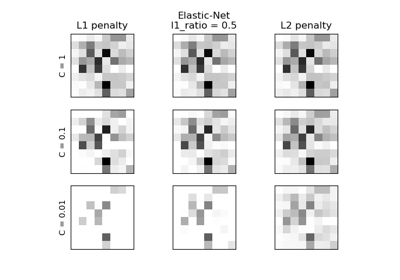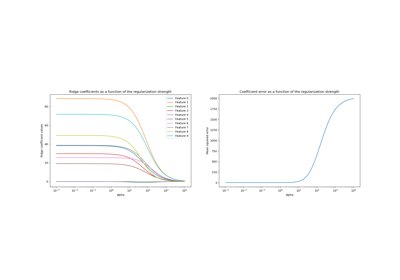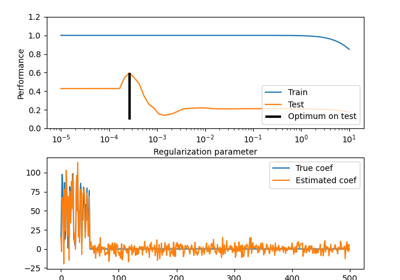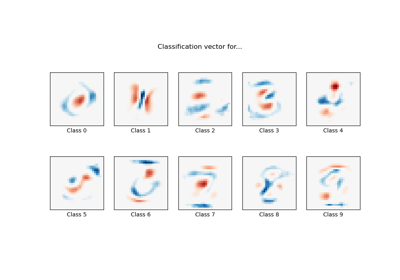注意
前往末尾下载完整的示例代码,或通过 JupyterLite 或 Binder 在浏览器中运行此示例。
SVC 的正则化参数缩放#
以下示例说明了在使用 支持向量机 进行 分类 时,缩放正则化参数的效果。对于 SVC 分类,我们关注的是以下方程的风险最小化
其中
\(C\) 用于设置正则化量
\(\mathcal{L}\) 是我们样本和模型参数的
损失函数。\(\Omega\) 是我们模型参数的
惩罚函数
如果我们将损失函数视为每个样本的个体误差,那么数据拟合项(即每个样本的误差总和)会随着样本数量的增加而增加。然而,惩罚项不会增加。
例如,当使用 交叉验证 来设置 C 的正则化量时,主问题与交叉验证折叠中的子问题之间会存在不同的样本数量。
由于损失函数依赖于样本数量,后者会影响 C 的选择值。由此产生的问题是“我们如何最优地调整 C 以适应不同数量的训练样本?”
# Authors: The scikit-learn developers
# SPDX-License-Identifier: BSD-3-Clause
数据生成#
在此示例中,我们探讨了在使用 L1 或 L2 惩罚时,重新参数化正则化参数 C 以考虑样本数量的效果。为此,我们创建了一个具有大量特征的合成数据集,其中只有少数特征是信息丰富的。因此,我们期望正则化将系数收缩到零(L2 惩罚)或恰好为零(L1 惩罚)。
from sklearn.datasets import make_classification
n_samples, n_features = 100, 300
X, y = make_classification(
n_samples=n_samples, n_features=n_features, n_informative=5, random_state=1
)
L1 惩罚情况#
在 L1 情况下,理论指出,在强正则化下,估计器无法像已知真实分布的模型那样进行预测(即使在样本量趋于无穷大的极限情况下),因为它可能将一些原本具有预测性的特征权重设置为零,从而引入偏差。但是,它确实指出,通过调整 C,可以找到正确的非零参数集及其符号。
我们定义一个带有 L1 惩罚的线性 SVC。
我们通过交叉验证计算不同 C 值下的平均测试得分。
import numpy as np
import pandas as pd
from sklearn.model_selection import ShuffleSplit, validation_curve
Cs = np.logspace(-2.3, -1.3, 10)
train_sizes = np.linspace(0.3, 0.7, 3)
labels = [f"fraction: {train_size}" for train_size in train_sizes]
shuffle_params = {
"test_size": 0.3,
"n_splits": 150,
"random_state": 1,
}
results = {"C": Cs}
for label, train_size in zip(labels, train_sizes):
cv = ShuffleSplit(train_size=train_size, **shuffle_params)
train_scores, test_scores = validation_curve(
model_l1,
X,
y,
param_name="C",
param_range=Cs,
cv=cv,
n_jobs=2,
)
results[label] = test_scores.mean(axis=1)
results = pd.DataFrame(results)
import matplotlib.pyplot as plt
fig, axes = plt.subplots(nrows=1, ncols=2, sharey=True, figsize=(12, 6))
# plot results without scaling C
results.plot(x="C", ax=axes[0], logx=True)
axes[0].set_ylabel("CV score")
axes[0].set_title("No scaling")
for label in labels:
best_C = results.loc[results[label].idxmax(), "C"]
axes[0].axvline(x=best_C, linestyle="--", color="grey", alpha=0.7)
# plot results by scaling C
for train_size_idx, label in enumerate(labels):
train_size = train_sizes[train_size_idx]
results_scaled = results[[label]].assign(
C_scaled=Cs * float(n_samples * np.sqrt(train_size))
)
results_scaled.plot(x="C_scaled", ax=axes[1], logx=True, label=label)
best_C_scaled = results_scaled["C_scaled"].loc[results[label].idxmax()]
axes[1].axvline(x=best_C_scaled, linestyle="--", color="grey", alpha=0.7)
axes[1].set_title("Scaling C by sqrt(1 / n_samples)")
_ = fig.suptitle("Effect of scaling C with L1 penalty")
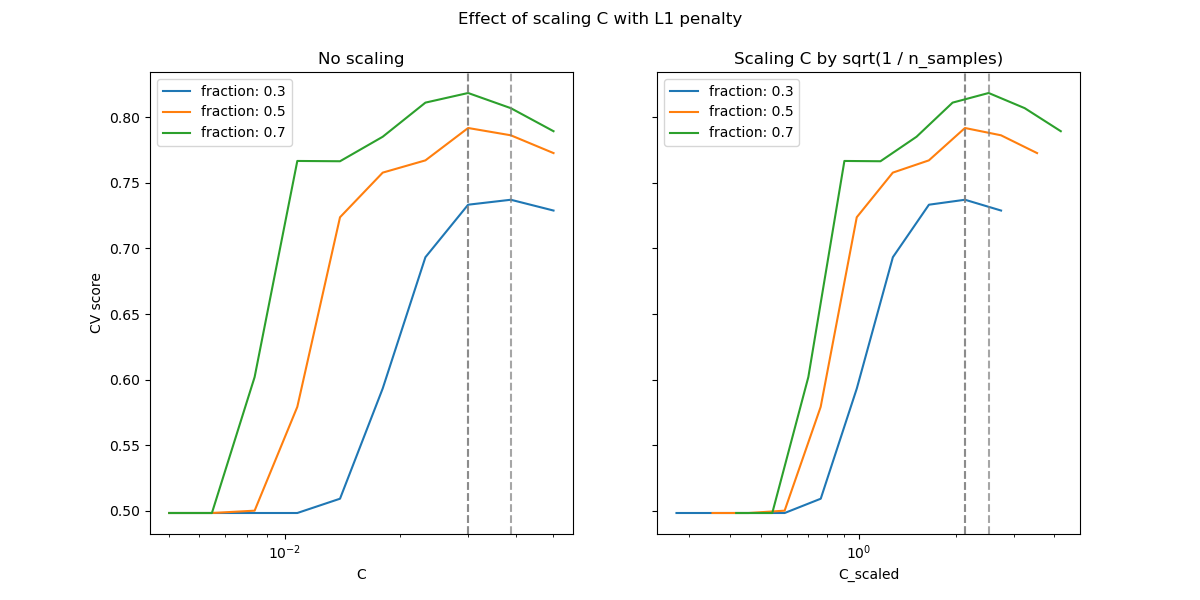
在小 C 值区域(强正则化),模型学习到的所有系数都为零,导致严重的欠拟合。实际上,此区域的准确率处于随机水平。
使用默认缩放会导致 C 的最优值相对稳定,而脱离欠拟合区域的过渡则取决于训练样本的数量。重新参数化会带来更稳定的结果。
例如,请参阅 On the prediction performance of the Lasso 或 Simultaneous analysis of Lasso and Dantzig selector 的定理 3,其中正则化参数总是被假定与 1 / sqrt(n_samples) 成比例。
L2 惩罚情况#
我们可以用 L2 惩罚进行类似的实验。在这种情况下,理论指出,为了实现预测一致性,惩罚参数应随着样本数量的增加而保持不变。
model_l2 = LinearSVC(penalty="l2", loss="squared_hinge", dual=True)
Cs = np.logspace(-8, 4, 11)
labels = [f"fraction: {train_size}" for train_size in train_sizes]
results = {"C": Cs}
for label, train_size in zip(labels, train_sizes):
cv = ShuffleSplit(train_size=train_size, **shuffle_params)
train_scores, test_scores = validation_curve(
model_l2,
X,
y,
param_name="C",
param_range=Cs,
cv=cv,
n_jobs=2,
)
results[label] = test_scores.mean(axis=1)
results = pd.DataFrame(results)
import matplotlib.pyplot as plt
fig, axes = plt.subplots(nrows=1, ncols=2, sharey=True, figsize=(12, 6))
# plot results without scaling C
results.plot(x="C", ax=axes[0], logx=True)
axes[0].set_ylabel("CV score")
axes[0].set_title("No scaling")
for label in labels:
best_C = results.loc[results[label].idxmax(), "C"]
axes[0].axvline(x=best_C, linestyle="--", color="grey", alpha=0.8)
# plot results by scaling C
for train_size_idx, label in enumerate(labels):
results_scaled = results[[label]].assign(
C_scaled=Cs * float(n_samples * np.sqrt(train_sizes[train_size_idx]))
)
results_scaled.plot(x="C_scaled", ax=axes[1], logx=True, label=label)
best_C_scaled = results_scaled["C_scaled"].loc[results[label].idxmax()]
axes[1].axvline(x=best_C_scaled, linestyle="--", color="grey", alpha=0.8)
axes[1].set_title("Scaling C by sqrt(1 / n_samples)")
fig.suptitle("Effect of scaling C with L2 penalty")
plt.show()
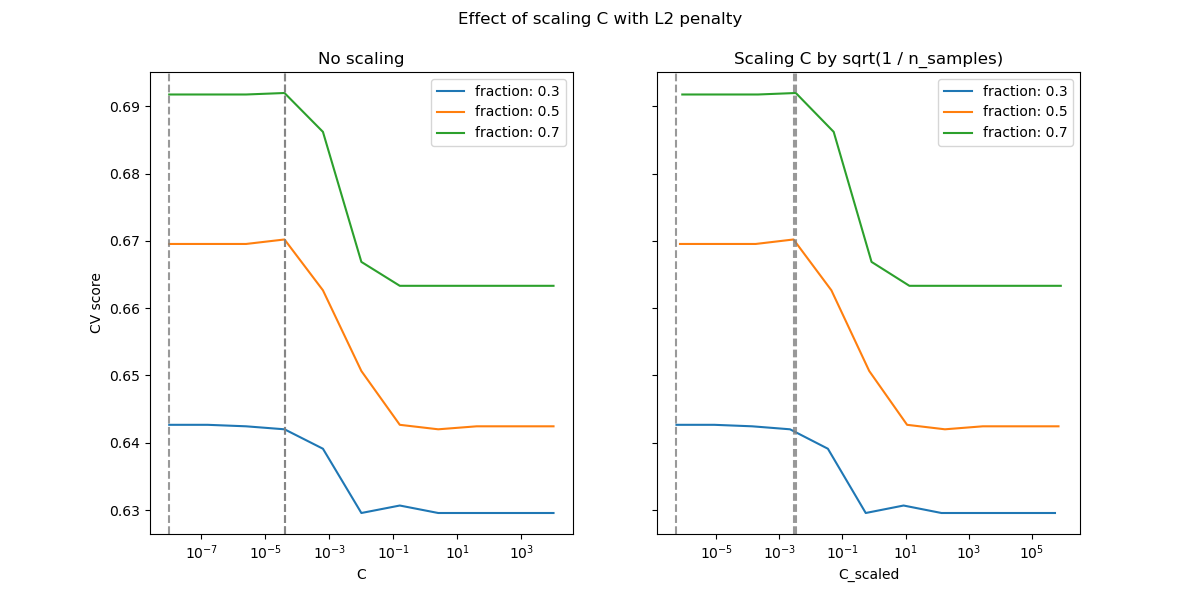
对于 L2 惩罚情况,重新参数化对正则化最优值的稳定性影响较小。脱离过拟合区域的过渡发生在更广泛的范围内,并且准确率似乎没有降低到随机水平。
尝试将 n_splits=1_000 增加以在 L2 情况下获得更好的结果,由于文档构建器的限制,此处未显示。
脚本总运行时间: (0 分 17.612 秒)
相关示例

